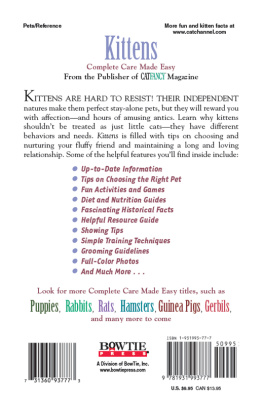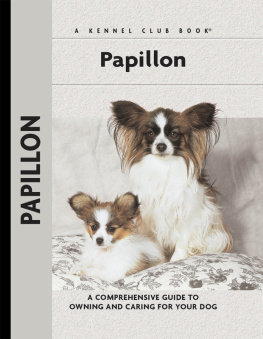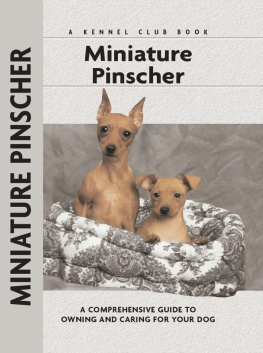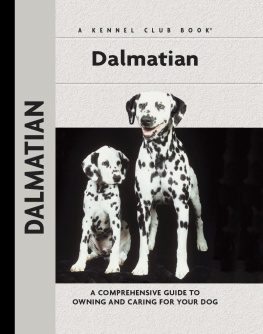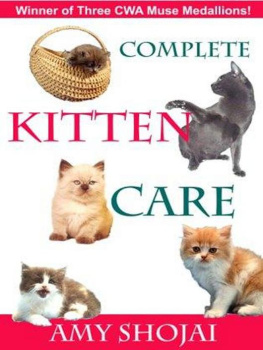


Karla Austin, Business Operations Manager
Nick Clemente, Special Consultant
Barbara Kimmel, Editor
Jackie Franza, Consulting Editor
Honey Winters, Designer
Indexed by Melody Englund
The kittens in this book are referred to as he and she in alternating chapters unless their gender is apparent from the activity discussed.
Photographs Copyright 2006 by Isabelle Francais. Photographs on pages 17, 41, 62, 73, 81, 121, 136, and 139 Copyright 2006 by Maureen Blaney Flietner.
Text Copyright 2006 by BowTie Press
All rights reserved. No part of this book may be reproduced, stored in a retrieval system, or transmitted in any form or by any means, electronic, mechanical, photocopying, recording, or otherwise, without the prior written permission of BowTie Press, except for the inclusion of brief quotations in an acknowledged review.
Library of Congress Cataloging-in-Publication Data
Meyer, Sandy.
Kittens : a guide to caring for your kitten / Sandy Meyer ; photographs by Isabelle Francais.
p. cm. (Complete care made easy)
Includes index.
ISBN 1-931993-77-7
1. Kittens. I. Title. II. Series.
SF447. M488 2006
636.8'07dc22
2006002160
BowTie Press
A Division of BowTie, Inc.
3 Burroughs
Irvine, California 92618
Printed and bound in Singapore
10 9 8 7 6 5 4 3 2 1
Acknowledgments
I N WRITING THIS BOOK, I DISCOVERED HOW MUCH I HAVE learned over the years from the excellent writers and editors at Cat Fancy magazine. Im grateful to Susan Logan, my friend and supervisor, for recommending me for this incredible project. My heartfelt thanks go to dear friends and family for their support and encouragement and to my patient editors for their guidance. Of course, special thanks go to the wonderful cats and kittens who have shared my home and lifeespecially Tripper, who spent many nights beside me during this project.
Sandy Meyer

Contents


Contrary to popular belief, cats are not cool and aloof loners. If you give your kitten plenty of love and affection, he will return it to you in kind.
Y OU ARE IN GOOD COMPANY WHEN IT COMES TO bringing a kitten into your household. Kitten ownership is on the rise, as evidenced in the 20052006 American Pet Product Manufacturers Association (APPMA) National Pet Owners Survey. And why not? Soft, curious, and overflowing with energy, a kittens adorable antics are bound to warm your heart and keep a smile on your face.
Kittens make great additions to households when owners make an effort to match the kittens personalities to their own lifestyles. And, with proper care, you will have a friend for years because cats often live into their twenties. So read on to arm yourself with information and get excited about your upcoming kitten adventures!
The Truth About Cats
The relationship between cats and humans has ebbed and flowed for thousands of years. They were once partners, then enemies, and finally friends. During the ups and downs, myths and folklore have become intertwined with truth, causing some serious misconceptions about cats. To get off on the right foot, lets clear up some of the confusion right now.

Independent and mysterious, cats like this Russian blue kitten have been part of our myths and fanciful tales for centuries.
Myth 1: Cats have nine lives.
As a species, cats are very prolific and resilient. They are survivors. However, each individual cat is small and vulnerable in a world full of dangers. As with all other creatures, human and otherwise, cats have only one life to live. They, too, are susceptible to disease, injury, and death. Although proper care and consideration can add years and quality to a cats life, she does not receive nine opportunities to get it right.
Myth 2: Cats are like dogs.
Cats and dogs are different species. Its true that dogs and cats share some similarities: both mammals have four legs, and most have hair over their bodies and possess tails. Many cats play fetch, just as many dogs do. However, these two animals have extremely different instincts. One of the most obvious differences is their social structure. Dogs are pack animals. They need to be part of a pack, and they depend on that group. Cats, on the other hand, are solitary hunters, taking care of themselves. Although cats can and do learn to live together peaceably, cats require adequate territories of their own. They need personal space and for that space to be respected.
Myth 3: Cats are an inexpensive and low-maintenance alternative to dogs.
The only inexpensive and low-maintenance cat is a neglected one. Both cats and dogs need a quality diet, regular veterinary visits, and daily care and attention. Although your cat doesnt need to be walked for exercise or to relieve herself, she does need mental and physical stimulation to keep her healthy. The only way your cat may be less expensive than a dog is if you are comparing the cat to a large dog breed. The larger the animal, the more food she eats and the larger medication dosage she would receive.
Myth 4: Cats are unfriendly and solitary animals.
Many people mistake the cats independence for unfriendliness. Some cats are fussier about whom they choose to spend their time with, but most are communicative and affectionate with their chosen people. Once cats understand that their basic survival needsshelter, food, and waterwill be consistently met, they can move on to luxuries such as human companionship. Many house cats meet their owners at the door when arriving home from school or work, follow their owners around the home, and sleep in their owners rooms and on their beds, if allowed. However, most cats are also quite comfortable spending time alone sunning in favorite spots and taking catnaps in quiet, solitary corners. There is a wonderful balance between socializing and meditating in the life of a cat.
Myth 5: Cats must have access to the outdoors to be truly happy.
Although it can be challenging to teach an outdoor cat that the indoors really is the best place to be, most cats adjust quite well. Cats are hunters by nature, but they do not require live prey to satisfy their hunting needs. Indoor-only cats live happy, satisfying lives with the help of their owners. And this indoor-only lifestyle reduces and eliminates countless dangers from such things as automobiles, cruel human behaviors, deadly chemicals, and threats from other animals. With a little patience, creativity, and consistency, you can transform your cats life into a full, indoor-only lifestyle. And you will be providing your precious pet with a longer, healthier life.
Next page
